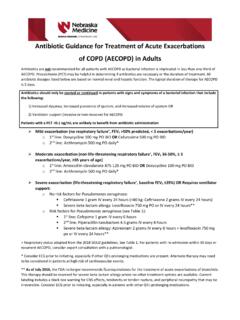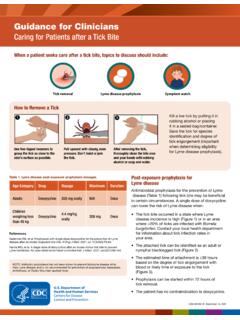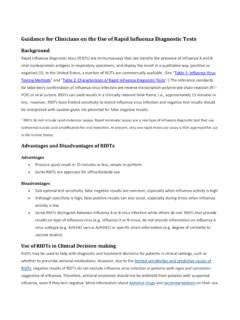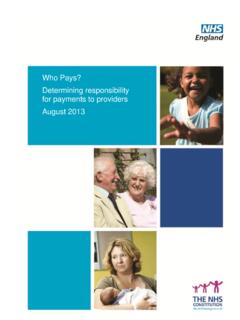Transcription of ICS Guidance for Prone Positioning of the Conscious COVID ...
1 ICS Guidance for Prone Positioning of the Conscious COVID Patient 2020. Authors: Peter Bamford, Andrew Bentley, Jane Dean, David Whitmore and Noamaan Wilson -Baig Prepared on behalf of the Intensive Care Society by: Peter Bamford Consultant in Intensive Care Medicine and Anaesthesia, Countess of Chester NHS Trust Andrew Bentley - Consultant in Intensive Care & Respiratory Medicine and Honorary Reader at Manchester University, Manchester University NHS. Foundation Trust, Wythenshawe Hospital Noamaan Wilson-Baig ST6 Academic Clinical Fellow in Anaesthesia and Honorary Researcher at Lancaster Medical School, Manchester University NHS. Foundation Trust, Wythenshawe Hospital Jane Dean Consultant Nurse, East Lancashire Teaching Hospital David Whitmore Consultant in Intensive Care and Anaesthesia, Countess of Chester NHS Trust Disclaimer: Neither the Intensive Care Society or the authors accept any responsibility for any loss or damage arising from actions or decisions based on the information contained within this publication.
2 Ultimate responsibility for patient safety with regards to the treatment of patients and the interpretation of the published material lies with the attending physician. The opinions expressed are those of the authors and the inclusion in this publication of material relating to a particular product or method does not amount to an endorsement of its value, quality, or the claims made by the manufacturer. Ratified by ICS Council Review Date: Introduction: The recent COVID -19 pandemic has seen the critical care community treating increasing numbers of patients with ARDS over recent weeks, with one Chinese study reporting the prevalence of hypoxic respiratory failure in these patients at around 19%. (1) Approximately 5% of all COVID -19 patients will require mechanical ventilation on an intensive care unit, with a further 14% requiring oxygen therapy.
3 Internationally, observations of critical care clinicians treating these patients in critical care have reported that patients with moderate to severe ARDS appear to have responded well to invasive ventilation in the Prone position, leading to Prone ventilation being recommended in international guidelines for the management of COVID -19. (2) This corroborates well with the findings of the PROSEVA trial; a recent meta-analysis and a Cochrane Systematic review, all of which support the early use of Prone ventilation in patients with moderate to severe ARDS to improve oxygenation and reduce mortality when compared with conventional supine ventilation. (3-5). Given the improvement in mechanically ventilated patients, it has been postulated that adopting the Prone position for Conscious COVID -19 patients requiring basic respiratory support, may also benefit patients in terms of improving oxygenation, reducing the need for invasive ventilation and potentially even reducing mortality.
4 The traditional supine position adopted by patients lying in hospital beds has long been known to be detrimental to their underlying pulmonary function. Supine Positioning leads to: Over-inflation of the ventral alveoli and atelectasis of the dorsal alveoli (due to an increased trans-pulmonary pressure gradient). Compression of alveoli secondary to direct pressure from the heart and the diaphragm being pushed cranially by the intra-abdominal contents. V/Q Mismatch As dorsal alveoli are preferentially perfused due to the gravitational gradient in vascular pressures they are poorly ventilation and highly perfused which manifests as hypoxaemia. Given the physiological benefits, Prone Positioning should apply to all patients regardless of whether they are intubated or not, the potential benefits include: Improved VQ matching and reduced hypoxaemia (secondary to more homogeneous aeration of lung and ameliorating the ventral-dorsal trans- pulmonary pressure gradient).
5 Reduced shunt (perfusion pattern remaining relatively constant while lung aeration becomes more homogenous). Recruitment of the posterior lung segments due to reversal of atelectasis Improved secretion clearance Prone Positioning is a simple intervention that can be done in most circumstances, is compatible with all forms of basic respiratory support and requires little or no equipment in the Conscious patient. Given its potential for improving oxygenation in COVID -19 patients we advocate that a trial of Conscious Prone Positioning be performed on all suitable patients on the ward. We have developed the following flow diagram to identify when it may be beneficial to trial Conscious proning. We have incorporated indications and contraindications as well as a guide on how patients should position themselves.
6 References: 1) Wu Z, McCoogan, JM. Characteristics of and important lessons from the Coronavirus Disease 2019 ( COVID -19) outbreak in China: summary of a report of 72314 cases from the Chinese center for disease controland prevention. JAMA 2020. 2) Alhazzani W, Moller M, Rhodes A et al. Surviving Sepsis Campaign: guidelines on the management of critically ill adults with Coronavirus Disease 2019 ( COVID -19). Intensive Care Medicine 2020. 3) Gu rin, C., Reignier, J., Richard, JC. Et al. PROSEVA Study Group. Prone Positioning in Severe Acute Respiratory Distress Syndrome. N Engl J Med (2013); 368: 2159 2168. 4) Sud, S., Friedrich, J., Adhikari, N. et al. Effect of Prone Positioning during mechanical ventilation on mortality among patients with acute respiratory distress syndrome: a systematic review and meta-analysis.
7 CMAJ (2014); 186 (10): 381-390. 5) Bloomfield, R., Noble, D., Sudlow, A. (2015) Prone position for acute respiratory failure in adults. Cochrane database of systematic reviews. Figure 1 Flow diagram decision tool for Conscious Proning process FiO2 28% or requiring basic respiratory support to achieve SaO2 92 96% (88-92% if risk of hypercapnic respiratory failure) AND suspected/confirmed COVID -19. YES. NO. Consider Prone position if ability to; NO. Continue - Communicate and co-operate with procedure. Continue supine - Rotate to front and adjust position independently supine - No anticipated airway issues YES. Absolute contraindications - Respiratory distress (RR 35, PaCO2 , accessory muscle use). - Immediate need for intubation - Haemodynamic instability (SBP < 90mmHg) or arrhythmia - Agitation or altered mental status YES Continue - Unstable spine/thoracic injury/recent abdominal surgery Supine or Relative Contraindications: consider - Facial injury escalation - Neurological issues ( frequent seizures) to medical - Morbid obesity team - Pregnancy (2/3rd trimesters).
8 - Pressure sores / ulcers Assist patient to Prone position (See Table 1). - Explain procedure/benefit - Ensure oxygen therapy and basic respiratory support secure with adequate length on the tubing - Pillows may be required to support the chest - Reverse trendelenberg position may aid comfort - Monitor oxygen saturations If drop then ensure O2. connected and working - Sedation must not be administered to facilitate proning Monitor Oxygen Saturations for 15 minutes: SaO2 92-96% (88-92% if risk of hypercapnic respiratory failure) and nil obvious distress YES NO. Continue proning process (See Table 1): If deteriorating oxygen saturations: - Change position every 1-2 hrs aiming to - Ensure oxygen is connected to patient achieve a Prone time as long as possible - Increase inspired oxygen - When not Prone aim to be sat at between - Change patients position 30-60 degrees upright - Consider return to supine position - Monitor oxygen saturations after every - Escalate to critical care if appropriate position change Discontinue if.
9 - Titrate down oxygen requirements as able - No improvement with change of position - Patient unable to tolerate position - RR 35, looks tired, using accessory muscles Table 1 Timed position changes for patients undergoing Conscious proning process Timed Position Changes: If patient fulfils criteria for proning ask the patient to switch positions as follows. Monitor oxygen saturations 15 minutes after each position change to ensure oxygen saturation has not decreased. Continue to monitor oxygen saturations as per the National Early Warning Score (NEWS). 30 minutes to 2 hours lying fully Prone (bed flat). 30 minutes to 2 hours lying on right side (bed flat). 30 minutes to 2 hours sitting up (30-60 degrees) by adjusting head of the bed 30 minutes to 2 hours lying on left side (bed flat).
10 30 minutes to 2 hours lying Prone again Continue to repeat the cycle . References used in the preparation of Figure 1 and Table 1. 1. Ding L et al. Critical Care 2020;24(1):28. 2. Emergency Department Critical Care (EMCrit). 2016. PulmCrit Wee- Proning the non-intubated patient. Retrieved from [Accessed 10th April, 2020].














